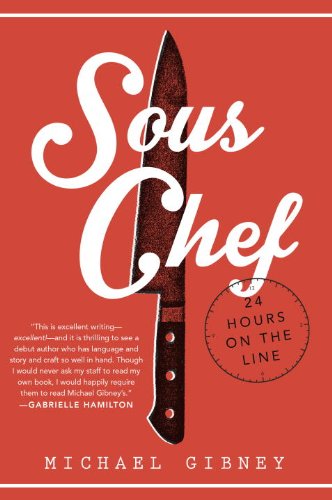
Sous Chef
24 Hours on the Line
کتاب های مرتبط
- اطلاعات
- نقد و بررسی
- دیدگاه کاربران
نقد و بررسی

Starred review from February 3, 2014
Forgoing the usual route of outrageous stories, name dropping, or straight ahead cookbooks, Gibney writes about what it’s actually like to work in the kitchen of a fine dining restaurant. Told in the second-person, from the point of a sous chef—a kitchen’s second-in-command and a position Gibney first reached at the age of 22—the narrative wonderfully captures a single day’s events, from morning deliveries and prep work through a busy service to the team’s cathartic release at a local bar. An experienced chef with an M.F.A. in nonfiction, Gibney is as skilled with words as he is with his 11-inch Sujihiki knife. In fact, when writing about this trusty knife his prose sounds more like poetry: “her outward lip traces lines in flesh with surgical exactitude, the convex shape of her inward face attenuates surface tension, releasing the meat. Cuts go slack at her touch; fish bows beside her.” This love of language permeates the whole book so that Gibney is able to tie together the off-color Spanglish dialogues of the staff with his drunken philosophizing on whether or not cooking is “just another form enlightened self interest” to create a story that is both cohesive and multifaceted.

Starred review from February 15, 2014
An experienced sous chef and first-time author skillfully deconstructs a 24-hour work cycle of a sous chef in a New York kitchen. Gibney builds his narrative around the intimate, intense and demanding dance occurring within the kitchen of a busy NYC restaurant, and his intent is clear from the beginning: He wants readers right beside him during the entire journey. The author includes a floor plan of the kitchen with its 17 zones and a diagram of the kitchen chain of command, from executive chef to busboy and food runner. For readers unfamiliar with a Honesuki ("a triangular Japanese poultry boning knife") or which part of the pig a guanciale comes from ("unsmoked Umbrian salumi made from salted and spiced pig jowl"), the author's inclusion of kitchen terms makes following along all the more fun. Gibney began working in restaurants at age 16, more than 13 years ago. When he was 22, he landed his first sous chef gig. "In that time," he writes, "I've seen all manner of operation--big, small, beautiful and ugly. I've climbed the ladder from dishwasher to chef and cooked at all the stations in between." In addition to the author's skill in the kitchen, Gibney displays solid storytelling ability. He breathes life into the mix of outsized personalities inhabiting the confined, hot, noisy space of the kitchen and illuminates the range of knowledge and skills required by his profession. Following a few pages enumerating the answers to possible questions wait staff might pose about a new dish, he writes, "You need to know everything about everything that's in every dish, and you must be able to identify which items may conflict with which dietary guidelines." Gibney ably relays mountains of information in this remarkable trek through his storehouse of knowledge. Sumptuously entertaining fare.
COPYRIGHT(2014) Kirkus Reviews, ALL RIGHTS RESERVED.

March 15, 2014
Trained both as a chef and a writer, Gibney leads readers on an excursion through the preparation and service of a single Friday night's dinner in an upscale Manhattan French restaurant. The day starts early for the kitchen staff, who inventory goods on hand; await the chef's decision on the evening's specials; make sure all the arrangements meet requirements for the appetizers, entr'es, and desserts to be served; deal with the state of mind and body of the cooking staff; coordinate with the waiters; and ultimately get the proper dishes, properly prepared, to the proper tables at the proper time. Such coordination of disparate activities is a restaurant's stock-in-trade, and Gibney documents how the system works and what can go wrong as the complex process moves along. Cooks don't always have mastery of English, some show up hungover or ill, and some may not show up at all. Culinary students can learn plenty here.(Reprinted with permission of Booklist, copyright 2014, American Library Association.)

























دیدگاه کاربران